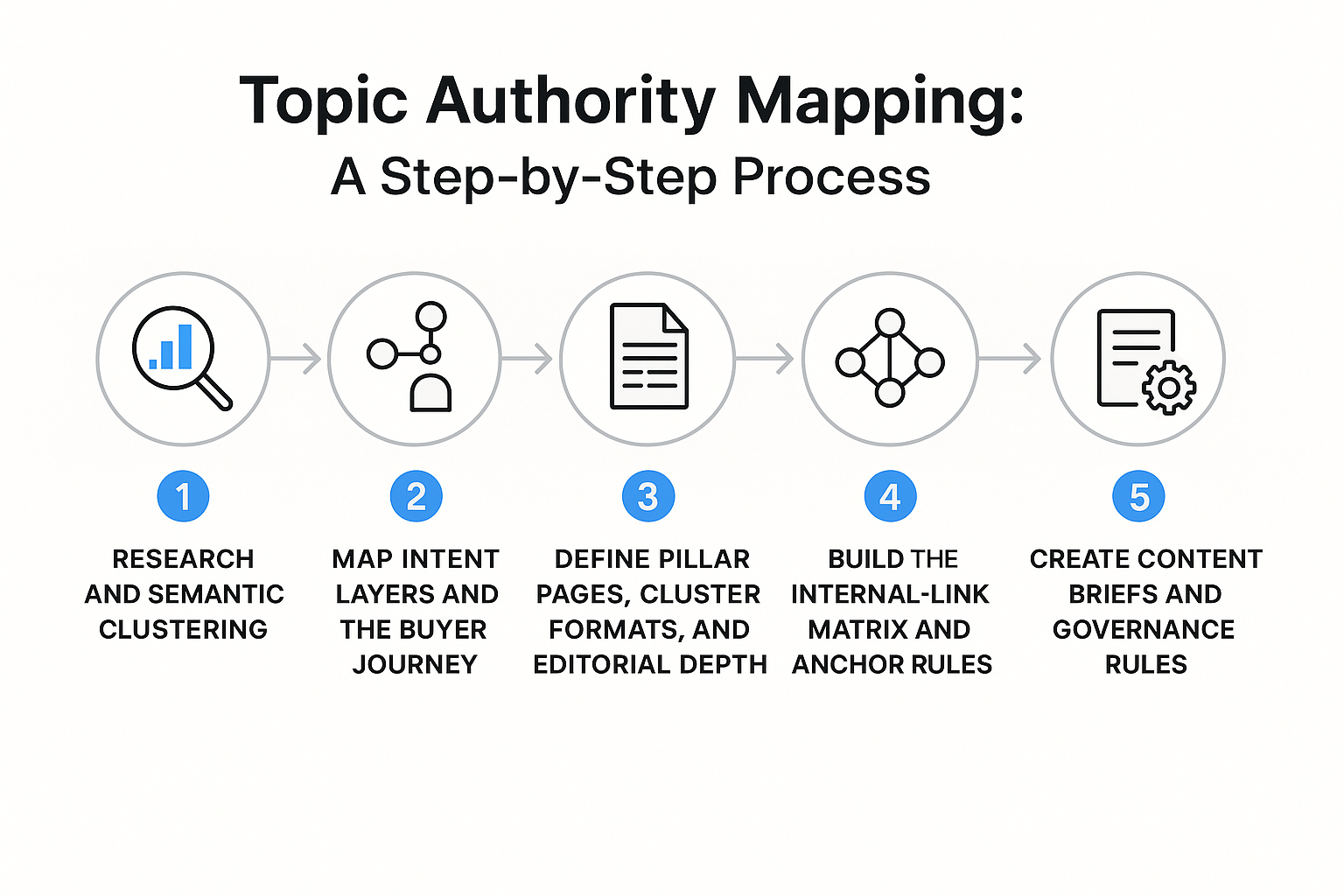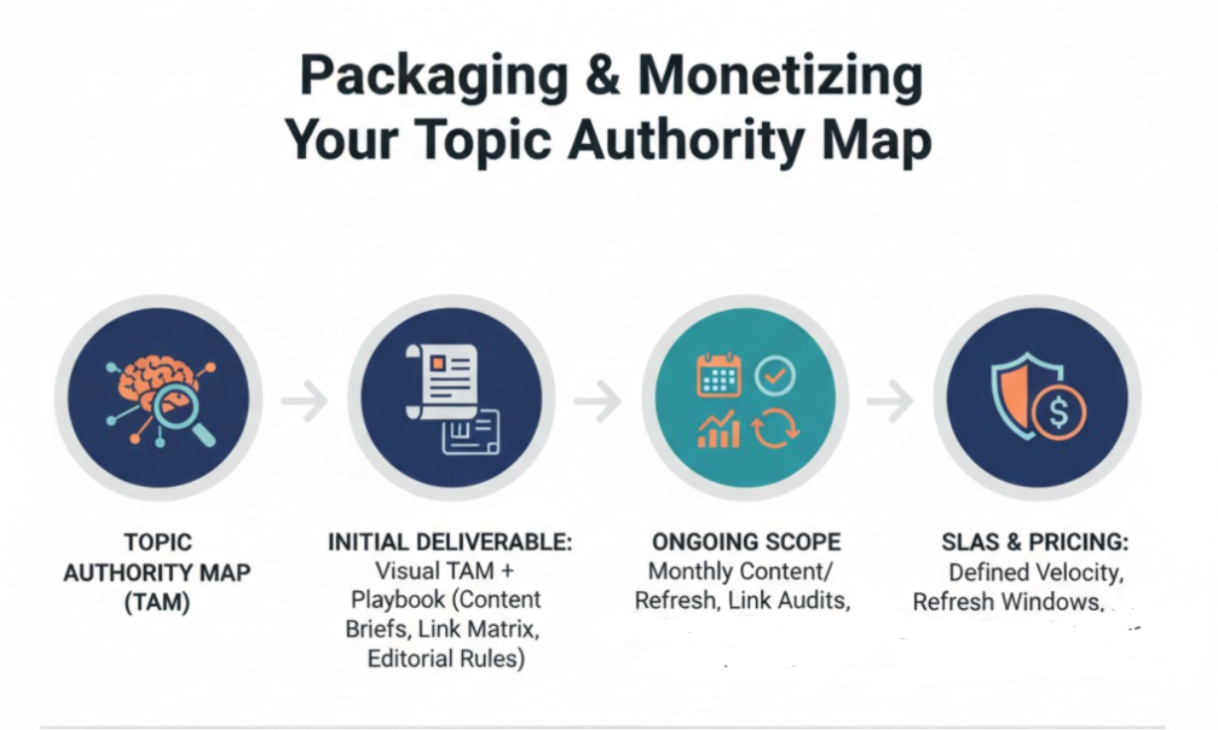| Topical authority mapping is the structured process of organising pillar pages, semantic clusters, intent layers, and internal-link pathways into a unified content architecture that improves search visibility and drives measurable funnel outcomes. It moves brands beyond keyword lists by connecting every page to a clear purpose, intent signal, and buyer-stage action. |
Ever wondered why your keyword spreadsheets look solid but still fail to move rankings or revenue? Or why content teams keep publishing, yet nothing meaningful happens in search?
Here’s the reality: 75% of searchers never go past page one. This means content that isn’t structured around clear themes, intent, and the buyer journey is practically invisible.
That’s where a Topic Authority Map (TAM) comes in. Instead of isolated keywords, you get a clear, connected system that shows how every page works together, how intent flows across the funnel, and how authority is built internally.
In this post, we’ll walk you through how to build a TAM from the ground up, so your marketing and SEO teams can create content that actually ranks, supports the funnel, and drives measurable organic growth. Read on!
Core Components of a Topic Authority Map

A high-quality TAM looks complex, yet every node shares seven required fields that make it operational.
- Core Topic / Pillar Page (Primary Node): Defines the central theme and search intent it will own. This acts as the anchor page that distributes authority to all supporting content.
- Supporting Subtopics / Cluster Pages: Semantic groupings that form SEO topical clusters around the pillar. These pages build depth and help search engines understand your expertise in the topic.
- Intent Tag + Buyer-Stage Label: Informational, commercial, or transactional intent matched to awareness, consideration, or decision stages. This ensures every page has a clear purpose in the buyer journey.
- Suggested Format & CTA Type: Guide, blog, comparison, calculator, FAQ, or tool, plus the on-page conversion cue. Choosing the right format increases relevance and improves user engagement.
- Internal-Link Matrix: Which pages link to which pillar, preferred anchor phrases, and maximum links per asset. This structure helps distribute authority and strengthens your topical hierarchy.
- Editorial Rules Summary: Minimum depth (subhead count, unique examples), refresh cadence, and canonical rules to prevent duplication. Strong editorial standards ensure consistency and prevent thin or redundant content.
- KPI Tags: Visibility, engagement, and conversion-assist metrics, so each node has an owner and a number. This makes reporting straightforward and keeps each asset accountable.
- Localisation Notes: Wording or example tweaks for US versus India audiences where search behaviour differs. Adapting content by region improves relevance and search performance across markets.
Collectively, these elements turn topical authority mapping from a conceptual diagram into an executable content strategy.
| 👉 Also Read: 27 Chrome Extensions For SEO To Outrank Your Competitors |
How to Build a Topic Authority Map?

Now that you know what goes into a TAM, let’s break down the exact steps to build one effectively:
Step 1: Research and Semantic Clustering
Begin with seed topics from stakeholder interviews and competitive gaps, then run semantic clustering tools to surface related queries rather than chasing raw volume.
Prioritise clusters by commercial relevance and the size of the content gap in the client’s vertical. The output is a shortlist of pillar page candidates, each with grouped cluster topics labelled by intent: a foundation for a robust content cluster strategy.
Step 2: Map Intent Layers and the Buyer Journey
Tag every proposed asset with both search intent (informational, commercial, or transactional) and buyer stage (awareness, consideration, or decision).
This dual label ensures each piece plays a defined role in moving a prospect forward, a principle central to buyer journey content mapping. Focus production on assets that close stage gaps or plug funnel leaks.
Step 3: Define Pillar Pages, Cluster Formats, and Editorial Depth
Define the scope of each pillar page. A pillar should be a comprehensive, evergreen resource that owns the core topic and links to all related cluster pages.
Match cluster formats to the corresponding intent signals:
- How-to guides for informational intent
- Comparisons for consideration content
- Calculators or ROI tools for decision-stage queries
Make sure you enforce a minimum depth per cluster (at least four H2s, original visuals, and two internal links) to avoid thin content that Google down-ranks.
Step 4: Build the Internal-Link Matrix and Anchor Rules
Draft a matrix that routes authority from every cluster to its pillar using contextual, descriptive anchors, reserving exact-match phrases for the highest-value links. Cap internal links at a sensible number (often 6–8) to preserve equity and user focus, and schedule quarterly link health checks to prevent decay.
Step 5: Create Content Briefs and Governance Rules
For each node, generate a brief that lists target intent, semantic keywords, H2/H3 outline, required internal links, and CTA.
Assign an owner, production SLA, and refresh cadence, then store all briefs in one governed workspace so editorial and SEO stay aligned. Link each brief back to its KPI tag; this makes reporting turnkey and supports retainer renewals.
| 💡 Pro Tip: Use semantic SEO tools to group related queries by meaning, not keywords. This helps you uncover hidden subtopics that strengthen your topical authority. |
Visual Templates and Client-Facing Deliverables
A Topic Authority Map is most effective when clients can see how everything connects. That’s why professional marketers present the TAM through a set of clear, visual deliverables that make strategy instantly understandable.
- Interactive Board (Miro or Notion): A dynamic workspace showing pillar–cluster relationships, intent layers, buyer-stage paths, and last-updated timestamps. Ideal for collaborative reviews and ongoing optimisation.
- Executive Summary PDF: A concise, one-page map designed for leadership teams. It highlights the overall structure, strategic priorities, and the metrics that define “what success looks like”.
- Link Matrix Spreadsheet: A tactical sheet for SEO and editorial teams detailing internal-link routes, anchor text rules and link-health status. This becomes the operational blueprint for maintaining authority flow.
For example, a SaaS brand like HubSpot might map a “CRM Software” pillar with clusters such as “CRM Benefits”, “CRM Comparisons” and “Best CRM Tools”, each colour-coded by intent and linked back to the main pillar.
Similarly, an e-commerce brand like Shopify could centre its TAM on “Start an Online Store”, with clusters for “Business Ideas”, “Marketing Tips” and “Store Design” that clearly guide users from awareness to decision.
Measurement Framework: KPIs and Reporting
| 🔎 Did you know: Pages in the top Google results have 3.8x more backlinks than pages that don’t rank. This highlights how important authority signals and consistent link optimisation are within your TAM. |
A Topic Authority Map only proves its value when it’s backed by measurable outcomes. To demonstrate impact, track performance at both the node level and the map level.
- Topical Coverage Growth: The percentage of planned nodes published across each pillar.
Organic Visibility by Intent Layer: Search Console impressions are segmented by intent tags to show which stages are gaining traction.
Internal-Link Health: Implemented versus planned internal links, including any broken or decayed paths.
Engagement by Buyer Stage: Time on page and scroll depth mapped to the asset’s assigned buyer stage.
Funnel Assists: Content-influenced leads, demo requests or trial starts captured through CRM touchpoints.
Pair these metrics with a monthly operational report and a quarterly strategic review that connects content activity to funnel movement. Use Search Console, GA4 and CRM data together to establish a single, reliable source of truth for both teams and leadership.
How to Package and Monetise Your Topic Authority Map

Successful marketers position the TAM as both a one-time deliverable and a roadmap for recurring services.
- Initial Deliverable: The visual TAM plus the playbook (content briefs, link matrix, editorial rules).
- Ongoing Scope: Monthly content production and refresh slots, link audits, KPI reporting, and quarterly strategy updates.
- SLAs: Defined content velocity (for example, six briefs per month), refresh windows, and link-implementation cadence.
- Pricing Logic: Value-based, tied to funnel impact and coverage growth instead of per-article rates
This structure aligns marketing revenue with client growth while keeping workloads predictable.
| 👉 Also Read: 21 Best SEO Blogs Every Website Owner Should Check Out |
Common Pitfalls and Governance Controls
Here’s a snapshot of the most common pitfalls teams face and the governance controls that prevent them:
- Thin Cluster Pages: Enforce minimum depth requirements and reject outlines that fail to add unique insight or value.
- Keyword Cannibalisation: Maintain strict canonical ownership within the map and audit drafts before publishing to prevent overlap.
- Link Decay: Run quarterly link checks and fix or redirect broken or outdated paths to preserve authority flow.
- Rigid Templates: Allow localisation adjustments, especially for markets like the US and India, to maintain relevance.
- No KPI Alignment: Assign at least one measurable outcome to every node before it enters production to ensure accountability.
| 💡 Pro Tip: Use on-page SEO essentials like semantic headings, focused intent and smart internal links to keep your TAM clean and prevent keyword overlap.
Here’s how it’ll help:
|
Move From Strategy to Execution Today!
Topical authority mapping turns content strategy from a keyword wish list into an operational system that earns topical authority, matches buyer intent, and fuels retainer economics.
To put this into motion:
- Draft a TAM for one high-priority client pillar this quarter.
- Spin out three content briefs, each mapped to a distinct intent layer.
- Implement the internal-link matrix and book monthly link audits.
- Set up a simple dashboard combining Search Console, GA4, and CRM proxies.
At Wittypen, we help marketing and SEO teams put this entire system into action. From building your Topic Authority Map to producing high-quality cluster content at scale, we support you with the structure, governance, and execution needed to drive predictable organic growth.
Ready to see how this works for your organisation? Speak with our team today.
FAQs
1. How many cluster pages do I need for a strong Topic Authority Map?
Most pillars require between 8 and 25 cluster pages, depending on the topic’s competitiveness. Highly saturated niches often require deeper clusters and more supporting content to build topical authority.
2. How long does topical authority mapping take to show results?
You’ll usually see impact within 8 to 16 weeks once enough clusters and internal links are live.
3. What tools help build a Topic Authority Map?
Semrush, Ahrefs, and Keyword Insights help with clustering, while Miro or Notion work well for mapping.
4. Is a TAM useful if we already have a content strategy?
Yes. It strengthens your strategy by identifying content gaps, aligning intent, and highlighting opportunities for improvement.









